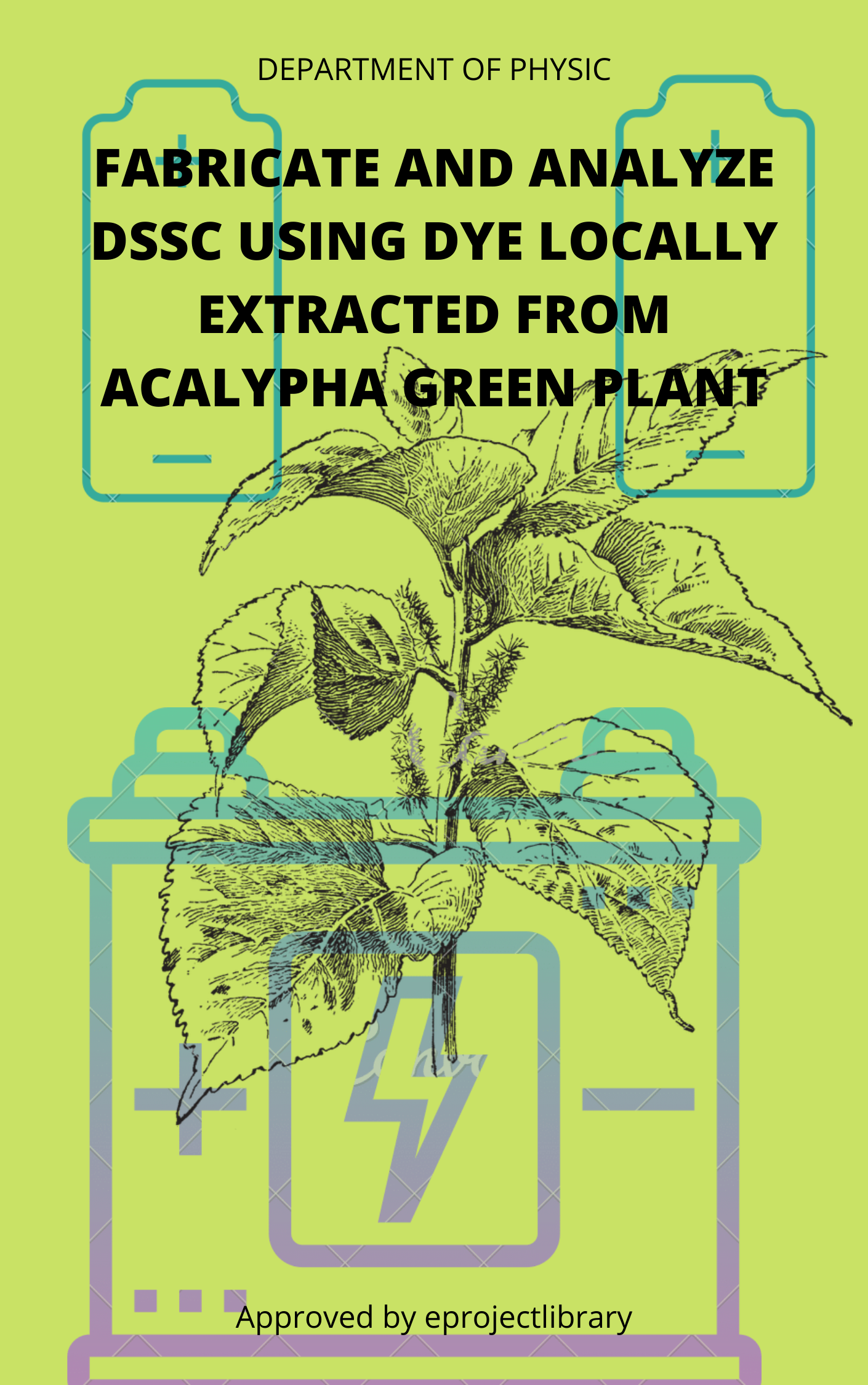FABRICATION AND ANALYSIS OF DYE-SENSITIZED SOLAR CELL (DSSC) USING DYE LOCALLY EXTRACTED FROM ACALYPHA GREEN PLANT
The aim of this project is to fabricate and analyze DSSC using dye locally extracted from Acalypha green plant.
GET RELATED PROJECT TOPIC HERE
CHAPTER ONE
1.0 INTRODUCTION
The world energy demand is expected to double within 40 years as the global population grows and raising the standard of living in developing countries such as Indian and china places a strain on available energy supplies. According to a 2004 United Nations study presented, the conservation scenario estimates that the population to peak in 2050-2060 to a little bit over 9 billion people. It was noted that our current energy consumption is around 15TW of power and could rise to about to 30 TW by the year 2050. In this generation, a solar cell, also known as Photovoltaic cell is one of the promising options of renewable energy. A solar cell is a photonic device that converts photons with specific wavelengths to electricity. Solar cell is divided into two groups which are the crystalline silicon and thin film.
New energy technologies are needed to meet population demand in a sustainable and environmental manner to enable human civilization to grow further and to hedge against environmental risks (Burhan et al, 2011).
Solar cells, one of the safest and cheaper ways to generate electricity, have been studied to a great extent since 1954. A solar cell is a solid electrical device that converts solar energy directly to electricity. There are two fundamental functions of solar cells: photo-generation of charge carriers (electrons and holes) in a light-absorbing material and separation of the charge carrier to a conductive interaction to transmit electricity.
BACKGROUND OF STUDY
1.1.1 WHAT IS SOLAR CELL
A solar cell is a solid electrical device that converts solar energy directly to electricity. The solar cell system we developed in this project is Dye-sensitized solar cell, composed of the TiO2 layer acting as the electron carrier and the organic dye layer acting as the electron generator, which will recover to its original state by electron donated by the electrolyte solution.
1.1.2 WHAT IS DYE SENSITIZED SOLAR CELL
A DYE-SENSITIZED SOLAR CELL is a low-cost solar cell which to the group of thin-film solar cells. It is based on a semiconductor formed between a photo-sensitized anode and an electrolyte, a photo-electrochemical system. It is a device for the conversion of visible light into electricity, based on photosensitization produced by the dyes on the wide band-gap mesoporous metal oxide semiconductors. This sensitization is due to the dye absorption of a part of the visible light spectrum.
The sensitized dye works by absorbing the sunlight which then converts it into electrical energy.
1.2 Stating the problems
The problem encounter was from the negative impacts on the economy. This was stem from two different sources:
- Creating energy with solar photovoltaic panels is a water-intensive process. Even though the solar cells themselves don’t use water to generate electricity, the manufacturing process requires some water.
- Large utility-scale solar panels take up a lot of space, which can result in environmental degradation and habitat loss. Solar farms that cover a large amount of land are likely to have an impact on the local fauna and flora, particularly on birds.
1.3 AIM AND OBJECTIVES
The aim of this project is to fabricate and analyze DSSC using dye locally extracted from Acalypha green plant.
The objectives of this project are divided into two parts and are stated below
- Develop new dye derivative from Acalypha green
- Determine factors that might influence the performance of DSSC such as transmittance and reflectance.
1.4 Scope of the study
The scope of this project is to study how locally made dye from Acalypha green affects the output voltage, current, and power of a DSSC.
1.5 Significance of the project
As solar cells remain the best substitute to a fuel-driven power source which has an adverse effect on the environment, intense research is needed to further improve the efficiency of power produced by these cells so as to meet the increasing demand. The research opens ways to improve on existing work is done and a pointer to future research work needs.




Reviews
There are no reviews yet.